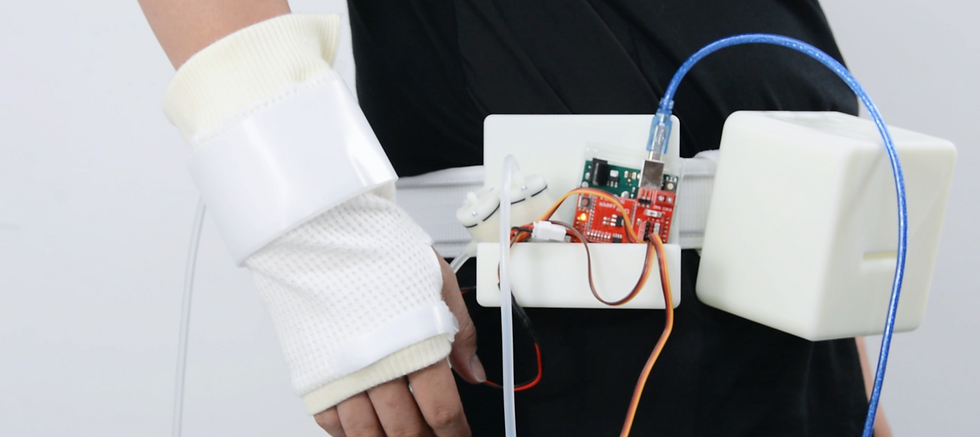
ANCHORCALM APP.
DIGITAL ANXIETY RELIEF COMPANION
OVERVIEW
A digital companion designed to support panic attack management. It helps users track emotional patterns, access guided relief techniques, and enhance their experience when used alongside the AnchorCalm device.
SKILLS
User Research, UX Design,UI Design, Product Design, Journey Map, HCI, Figma, Prototyping
ROLE
Product Designer
UI/UX Designer
Researcher
DATE
2024
RESEARCH
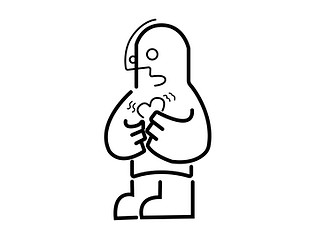
PANIC ATTACK
is an abrupt and discrete experience of intense fear and anxiety or acute discomfort, accompanied by symptoms such as heart palpitations, shortness of breath, sweating, trembling, and worries about going crazy, losing control, or dying.
6,000,000+
american adults are affected by panic disorder, according to The National Institute of Mental Health.
EXPERIENCE AND RELIEF SURVEY
UNITED KINGDOM:
50 Responses
Age: 18-99
Health Issues: Panic
Disorder, Anxiety
UNITED STATES:
80 Responses
Age: 18-44 (47%),
45-99 (53%)
Health Issues:
Anxiety Disorders

CHINA:
55 Responses
Age: 18-99
Health Issues:
Panic Disorder,
Anxiety
INDIA:
56 Responses
Age: 18-99
Health Issues:
Anxiety

71.4%
of respondents don't have any supportive tools to cope with sudden panic attacks.

MOST TYPICAL SYMPTOMS OF PANIC ATTACKS
-
72% Rapid heartbeat
-
67% Shortness of breath
-
60% Sweating/ Trembling
-
43% Dizziness/ Nausea
-
38% Fear of going crazy, losing control, or dying

TOP METHODS TO RELIEVE SYMPTOMS
-
60% Breathing control
-
48% Shifting attention
-
41% Mindfulness meditation
-
40% Focusing on senses
-
40% Seeking help from
others
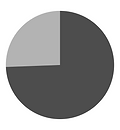
74.4%
of them want to have products that can help them alleviate panic attacks.

THE MAIN TRIGGERING FACTORS
-
69% Stress from life
-
47% Traumatic experiences
-
37% Specific situations
-
36% Issues in relationships
-
24% External stimuli

TOP WORRIES DURING PANIC ATTACKS
-
57% Feeling trapped
-
44% Threats to health
-
42% Previous experiences
-
41% Embarrassment
-
25% Can't obtain assistance
To build a deep understanding of panic attack experiences, I conducted user research through surveys, interviews, and secondary analysis. By analyzing quantitative data on symptom patterns and relief methods, alongside qualitative insights from real experiences, I uncovered key pain points, triggers, coping behaviors, and unmet needs.
PAIN POINTS
SELF-REGULATION
Patients feel overwhelmed and unable to focus on calming techniques, making symptom management ineffective or inconsistent.
FEELING TRAPPED
Panic attacks are unpredictable, and patients struggle to seek help or feel reassured, intensifying fear and helplessness.
ANXIETY
IN PULIC
In crowded spaces, patients feel self-conscious and hesitant to seek help, leading to avoidance behaviors and worsened anxiety.
HYPERVENTILATION
Patients resort to ineffective coping methods, lacking real-time feedback to regulate breathing and prevent overcompensation.
ACCESSIBILITY
Patients struggle to find immediate relief and track progress, making it harder to identify triggering patterns and build long-term coping strategies.
PERSONA & JOURNEY MAP
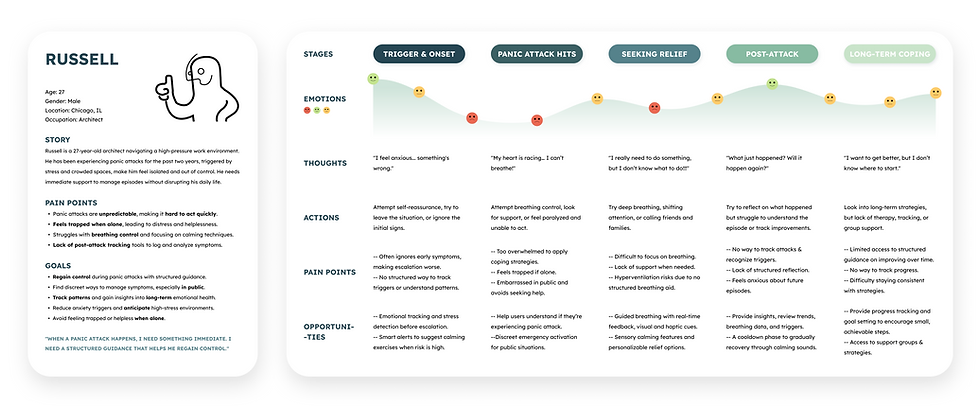
By creating a user persona and journey map, I gained a deeper understanding of the pain points, behaviors, and needs of individuals experiencing panic attacks. This process uncovered key design opportunities, ensuring that AnchorCalm delivers practical, user-centered solutions for both immediate relief and long-term anxiety management.
MID-FIDELITY WIREFRAMES
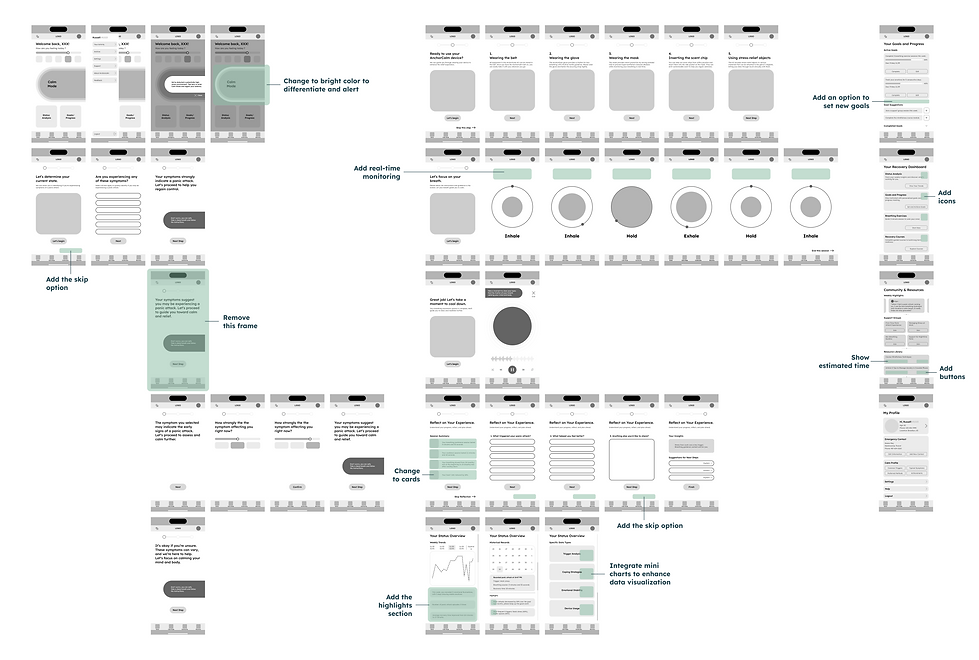
I developed mid-fidelity wireframes in Figma to quickly visualize and refine the design. After usability testing, I analyzed feedback and key recommendations, such as enhancing data visualization with mini charts, integrating real-time monitoring, and simplifying the user flow. By iterating on these insights, I refined the design and transitioned to a more user-centered final version.
FINAL DELIVERABLE

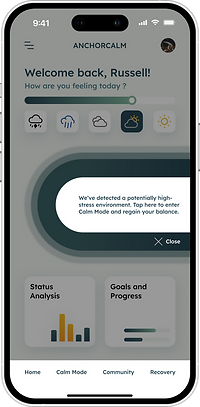
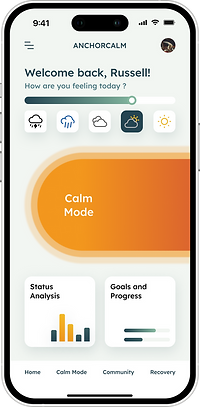
HOME SCREEN & PANIC DETECTION ALERTS
The home screen provides users with quick emotional tracking, progress, status analysis, and a prominent Calm Mode button for immediate relief. When a high-pressure situation is detected, a pop-up alert and color shift guide users to take action, ensuring timely intervention.
QUICK DIAGNOSTIC
ASSISTANCE
Before activating the Calm Mode, users can answer a few guided questions to determine whether they are experiencing a panic attack. This feature helps users recognize their symptoms, assess severity, and proceed with the most appropriate next step, whether it’s breathing guidance or seeking external support.
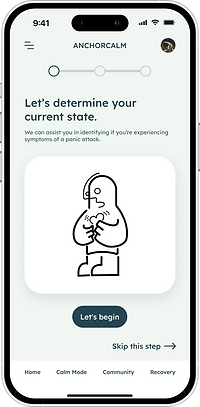

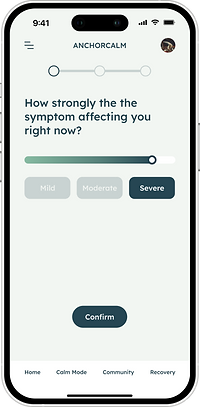
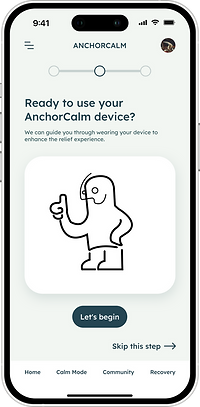
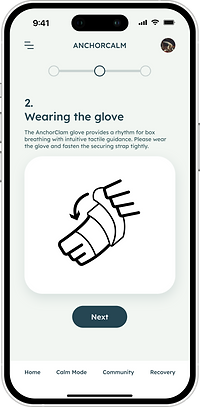
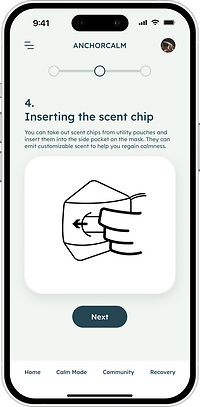
ANCHORCALM DEVICE
GUIDANCE
When users activate the Calm Mode, the interface provides step-by-step guidance for wearing the AnchorCalm device, ensuring a smooth transition from recognition to relief.
BREATHING GUIDE
& LIVE MONITORING
When paired with the AnchorCalm device, a dynamic breathing guide uses visuals, sound cues, and haptic feedback to help users regulate their breath. Real-time monitoring provides breathing rate and heart rate feedback for enhanced reassurance and control.
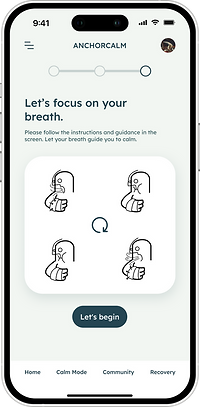
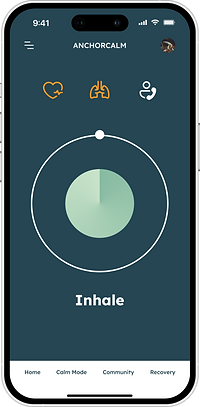

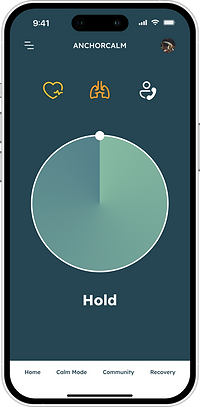


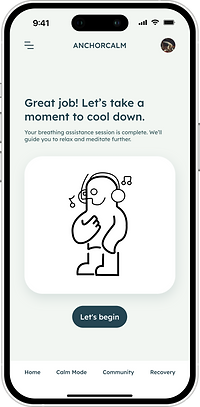
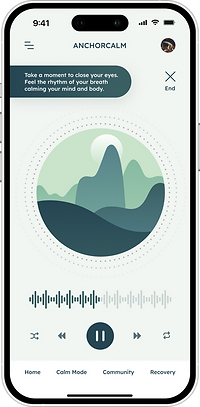
COOLDOWN MODE
After calming down, users enter Cooldown Mode, where they can listen to soothing audio, view calming visuals, and ease back into a relaxed state. This phase ensures a smooth transition from intervention to recovery, helping users regain stability before moving forward.
POST-EPISODE REFLECTION & INSIGHTS
After calming down, users are guided through a structured reflection process, where they can review their breathing data, log their triggers, and receive tailored suggestions to improve future coping strategies.
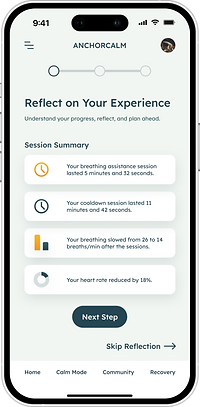



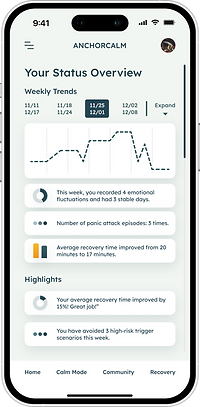
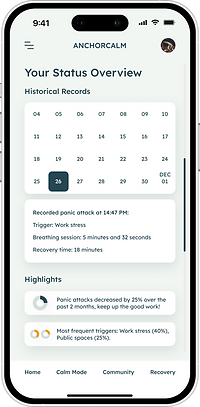
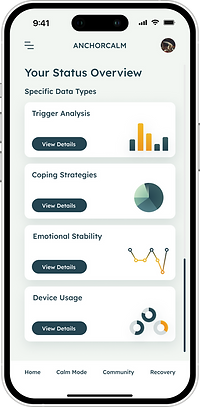
STATUS OVERVIEW
Users can review key session data such as breathing rate changes, heart rate trends, and recovery time. This overview helps users identify patterns and track progress over time.
RECOVERY DASHBOARD
& PROGRESS TRACKING
The Recovery dashboard allows users to track weekly trends, episode frequency, and symptom improvements. It also features goal-setting and progress tracking tools to encourage healthy habits and self-improvement.

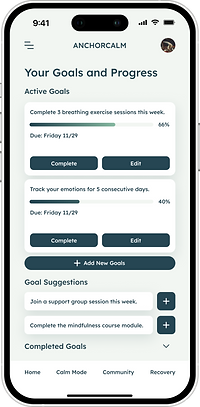
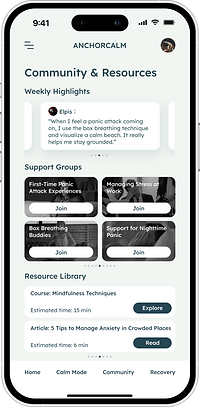
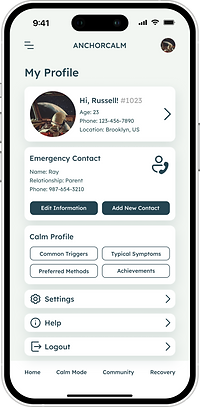
COMMUNITY & PROFILE
Users can join support groups, browse mental health resources, and create a supportive recovery network. In My Profile, users can customize their experience by managing personal clam profile and emergency contacts, ensuring the app adapts to their specific needs.
THE ANCHORCALM DEVICE
